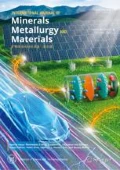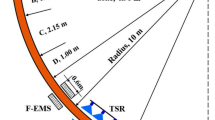Abstract
The trouble-free and efficient operation of paste thickeners requires an optimal design and the cooperation of each component. When underflow discharging is suspended, alleviating the vast torque that the remaining solids within the thickeners may place on rakes mainly lies in the circulation unit. The mechanism of this unit was analyzed, and a mathematical model was developed to describe the changes in underflow solid content and yield stress. The key parameters of the circulation unit, namely, the height and flow rate, were varied to test its performance in the experiments with a self-designed laboratorial thickening system. Results show that the circulation unit is valid in reducing underflow solid fraction and yield stress to a reasonable extent, and the model could be used to describe its efficiency at different heights and flow rates. A suitable design and application of the circulation unit contributes to a cost-effective operation of paste thickeners.
Similar content being viewed by others
References
S.C. Pan, C.C. Lin, and D.H. Tseng, Reusing sewage sludge ash as adsorbent for copper removal from wastewater, Resour. Conserv. Recycl., 39(2003), No. 1, p. 79.
F. Concha and R. Bürger, Thickening in the 20th century: A historical perspective, Min. Metall. Explor., 20(2003), No. 2, p. 57.
H.Z. Jiao, S.F. Wang, Y.X. Yang, and X.M. Chen, Water recovery improvement by shearing of gravity-thickened tailings for cemented paste backfill, J. Cleaner Prod., 245(2020), art. No. 118882.
D.L. Wang, Q.L. Zhang, Q.S. Chen, C.C. Qi, Y. Feng, and C.C. Xiao, Temperature variation characteristics in flocculation settlement of tailings and its mechanism, Int. J. Miner. Metall. Mater., 27(2020), No. 11, p. 1438.
M. Benzaazoua, J. Ouellet, S. Servant, P. Newman, and R. Verburg, Cementitious backfill with high sulfur content physical, chemical, and mineralogical characterization, Cem. Concr. Res., 29(1999), No. 5, p. 719.
M. Fall and M. Benzaazoua, Modeling the effect of sulphate on strength development of paste backfill and binder mixture optimization, Cem. Concr. Res., 35(2005), No. 2, p. 301.
M. Benzaazoua, P. Marion, I. Picquet, and B. Bussière, The use of pastefill as a solidification and stabilization process for the control of acid mine drainage, Miner. Eng., 17(2004), No. 2, p. 233.
A.X. Wu, Y. Yang, H.Y. Cheng, S.M. Chen, and Y. Han, Status and prospects of paste technology in China, Chin. J. Eng., 40(2018), No. 5, p. 517.
Y.X. Yang, T.Q. Zhao, H.Z. Jiao, Y.F. Wang, and H.Y. Li, Potential effect of porosity evolution of cemented paste backfill on selective solidification of heavy metal ions, Int. J. Environ. Res. Public Health, 17(2020), No. 3, p. 814.
M. Benzaazoua, M. Fall, and T. Belem, A contribution to understanding the hardening process of cemented pastefill, Miner. Eng., 17(2004), No. 2, p. 141.
M. Pokharel and M. Fall, Combined influence of sulphate and temperature on the saturated hydraulic conductivity of hardened cemented paste backfill, Cem. Concr. Compos., 38(2013), p. 21.
H.Z. Jiao, S.F. Wang, A.X. Wu, H.M. Shen, and J.D. Wang, Cementitious property of NaAlO2-activated Ge slag as cement supplement, Int. J. Miner. Metall. Mater., 26(2019), No. 12, p. 1594.
C.C. Qi and A. Fourie, Cemented paste backfill for mineral tailings management: Review and future perspectives, Miner. Eng., 144(2019), art. No. 106025.
X. Zhao, A. Fourie, and C.C. Qi, Mechanics and safety issues in tailing-based backfill: A review, Int. J. Miner. Metall. Mater., 27(2020), No. 9, p. 1165.
D.V. Boger, Rheology and the resource industries, Chem. Eng. Sci., 64(2009), No. 22, p. 4525.
S.P. Usher, Suspension Dewatering: Characterisation and Optimisation [Dissertation], University of Melbourne, Victoria, 2002, p. 20.
T. Belem and M. Benzaazoua, Design and application of underground mine paste backfill technology, Geotech. Geol. Eng., 26(2008), No. 2, p. 147.
T. Meggyes and A. Debreczeni, Paste technology for tailings management, Land Contam. Reclam., 14(2006), No. 4, p. 815.
R.J. Jewell and A.B. Fourie, Paste and Thickened Tailings—A Guide, 3rd ed, Australian Centre for Geomechanics, Western Australia, 2015.
M.C. Mulligan and L. Bradford, Soluble metal recovery improvement using high density thickeners in a CCD circuit: Ruashi II case study, J. South Afr. Inst. Min. Metall., 109(2009), No. 11, p. 665.
F.W. Brackebusch, Basics of paste backfill systems, Int. J. Rock Mech. Min. Sci. Geomech. Abstr., 32(1995), No. 3, p. 122A.
S.P. Usher and P.J. Scales, Steady state thickener modelling from the compressive yield stress and hindered settling function, Chem. Eng. J., 111(2005), No. 2–3, p. 253.
Y. Wang, A.X. Wu, Z.E. Ruan, Z.H. Wang, Z.S. Wei, G.F. Yang, and Y.M. Wang, Reconstructed rheometer for direct monitoring of dewatering performance and torque in tailings thickening process, Int. J. Miner. Metall. Mater., 27(2020), No. 11, pp. 1430–1437.
K.A. Landman, L.R. White, and R. Buscall, The continuous-flow gravity thickener: Steady state behavior, AIChE J., 34(1988), No. 2, p. 239.
H.J. Wang, X. Zhou, A.X. Wu, Y.M. Wang, and L.H. Yang, Mathematical model and factors of paste thickener rake torque, Chin. J. Eng., 40(2018), No. 6, p. 673.
H.Z. Jiao, Research on the Tailings Flocs Behavior and Dewatering Mechanism in Deep Cone Thickening [Dissertation], University of Science and Technology Beijing, Beijing, 2014, p. 67.
M. Rudman, D.A. Paterson, and K. Simic, Efficiency of raking in gravity thickeners, Int. J. Miner. Process., 95(2010), No. 1–4, p. 30.
M. Rudman, K. Simic, D.A. Paterson, P. Strode, A. Brent, and I.D. Šutalo, Raking in gravity thickeners, Int. J. Miner. Process., 86(2008), No. 1–4, p. 114.
C.K. Tan, J. Bao, and G. Bickert, A study on model predictive control in paste thickeners with rake torque constraint, Miner. Eng., 105(2017), p. 52.
L.H. Yang, H.J. Wang, A.X. Wu, L.F. Zhang, and H. Chen, Regulation and a mathematical model of underflow in paste thickeners based on a circular system design, Chin. J. Eng., 39(2017), No. 10, p. 1507.
S.P. Usher, R. Spehar, and P.J. Scales, Theoretical analysis of aggregate densification: Impact on thickener performance, Chem. Eng. J., 151(2009), No. 1–3, p. 202.
W.F. Eckert, J.H. Masliyah, M.R. Gray, and P.M. Fedorak, Prediction of sedimentation and consolidation of fine tails, AIChE J., 42(1996), No. 4, p. 960.
S. Azam, S. Jeeravipoolvarn, and J.D. Scott, Numerical modeling of tailings thickening for improved mine waste management, J. Environ. Inf., 13(2009), No. 2, p. 111.
H.Z. Jiao, A.X. Wu, H.J. Wang, S.P. Zhong, R.M. Ruan, and S.H. Yin, The solids concentration distribution in the deep cone thickener: A pilot scale test, Korean J. Chem. Eng., 30(2013), No. 2, p. 262.
S.K. Gawu and A.B. Fourie, Assessment of the modified slump test as a measure of the yield stress of high-density thickened tailings, Can. Geotech. J., 41(2004), No. 1, p. 39.
Q.D. Nguyen and D.V. Boger, Application of rheology to solving tailings disposal problems, Int. J. Miner. Process., 54(1998), No. 3–4, p. 217.
A. Kesimal, E. Yilmaz, and B. Ercikdi, Evaluation of paste backfill mixtures consisting of sulphide-rich mill tailings and varying cement contents, Cem. Concr. Res., 34(2004), No. 10, p. 1817.
H.Y. Cheng, S.C. Wu, A.X. Wu, and W.H. Cheng, Grading characterization and yield stress prediction based on paste stability coefficient, Chin. J. Eng., 40(2018), No. 10, p. 1168.
A. Kesimal, E. Yilmaz, B. Ercikdi, I. Alp, and H. Deveci, Effect of properties of tailings and binder on the short-and long-term strength and stability of cemented paste backfill, Mater. Lett., 59(2005), No. 28, p. 3703.
K. Terzaghi, R.B. Peck, and G. Mesri, Soil Mechanics in Engineering Practice, 3rd ed., John Wiley & Sons, Inc., New York, 1995.
J.B. Farrow, R.R.M. Johnston, K. Simic, and J.D. Swift, Consolidation and aggregate densification during gravity thickening, Chem. Eng. J., 80(2000), No. 1–3, p. 141.
N.Q. Dzuy and D.V. Boger, Yield stress measurement for concentrated suspensions, J. Rheol., 27(1983), No. 4, p. 321.
H.Y. Cheng, S.C. Wu, H. Li, and X.Q. Zhang, Influence of time and temperature on rheology and flow performance of cemented paste backfill, Constr. Build. Mater., 231(2020), art. No. 117117.
X. Zhou, X.G. Jin, P.Z. Liu, H.P. Wu, and H.W. Li, Prediction model for underflow concentration of deep cone thickener based on dynamic thickening experimentation, Met. Mine, 12(2017), p. 39.
X. Jin, Experimental study on influence factors on rheological properties of underflow in deep-cone thickeners, Mod. Min., 31(2015), No. 3, p. 201.
M.H. Zhang, C.F. Ferraris, H. Zhu, V. Picandet, M.A. Peltz, P. Stutzman, and D.D. Kee, Measurement of yield stress for concentrated suspensions using a plate device, Mater. Struct., 43(2010), No. 1–2, p. 47.
J.E. Wallevik, Relationship between the Bingham parameters and slump, Cem. Concr. Res., 36(2006), No. 7, p. 1214.
S. Wang, X.P. Song, X.J. Wang, Q.S. Chen, J.C. Qin, and Y.X. Ke, Influence of coarse tailings on flocculation settlement, Int. J. Miner. Metall. Mater., 27(2020), No. 8, p. 1065.
Acknowledgement
This work was financially supported by the National Natural Science Foundation of China (No. 51834001).
Author information
Authors and Affiliations
Corresponding author
Rights and permissions
About this article
Cite this article
Li, H., Wu, Ax., Wang, HJ. et al. Changes in underflow solid fraction and yield stress in paste thickeners by circulation. Int J Miner Metall Mater 28, 349–357 (2021). https://doi.org/10.1007/s12613-020-2184-z
Received:
Revised:
Accepted:
Published:
Issue Date:
DOI: https://doi.org/10.1007/s12613-020-2184-z




